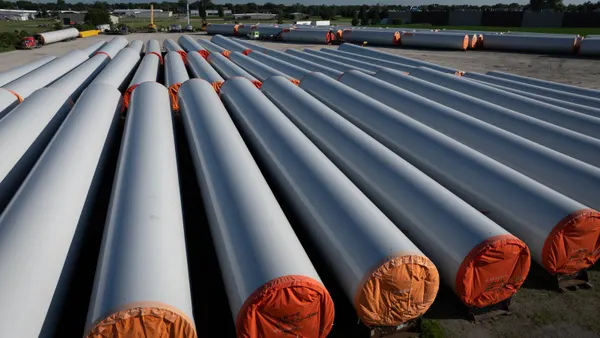Dive Brief
- Armatron Systems, an Arizona-based 3D construction printing company, has secured a patent for an on-site printer that officials say can create a slab as long as 60 feet in less than a minute.
- The 3D printer uses a slip-form mold extrusion system that limits bubbles and air in the concrete, and shortens the curing process so the concrete can be ready to support weight moments after being laid. This also allows the Armatron system to build curvilinear walls, which officials said most 3D printers cannot build.
- The patent is the first step in the process of rolling out the 3D printers for widespread use, the company told Construction Dive. Armatron plans nine to 12 months of further testing with end users before introducing the technology to a wide range of contractors.
Dive Insight
Increased options, such as allowing a builder to make slabs from as thin as one-fourth inch to as thick as 30 inches, set the printer apart from other models, Armatron co-founder and COO Blair Souter told Construction Dive.
When the Armatron printers are ready to be marketed, Souter said the company will license them, not sell them, so the firm can maintain quality control and train end users on the product, helping them implement it with their own construction technologies.
Assembling the printer onsite is intended to be streamlined as well, said co-founder Anri Kirkoryan, with no piece weighing more than 70 pounds. Kirkoryan said the system, which can be set up in 35 to 45 minutes and be ready to cast concrete, has no proprietary mix — so any concrete can be used in the casting.
The Armatron printer was partly developed to build shelters quickly, such as after natural disasters, Kirkoryan said. Though the printer can make a 60-foot-long brick in under a minute, the usual operating pace is about 20 feet a minute, he said. At that speed, the team estimated the machine could build a 1,500-square-foot space in two days, from foundation to roof.
Gregg Lewis, executive vice president for promotion strategy and communication at the National Ready Mixed Concrete Association (NRMCA), thinks the Armatron 3D printers would be useful to build emergency housing in disaster areas, which would be far more permanent than trailers or tents.
Most of the buildings Armatron has built are rounded houses with windows. Armatron’s biggest interest, CEO Brian Giles said, is building “Arabian Nights-style homes” in the Middle East, as 3D-printed construction is popular in the United Arab Emirates. That said, Giles indicated it could have more practical domestic uses, such as pylons for railway systems or water tanks.
Armatron’s executives also think the 3D printer could be an answer to the skilled labor shortage because few workers are needed to operate a printer.
NRMCA's Lewis agreed. “We’re obviously very interested in it,” he said. “It’s innovation, and the industry as a whole supports our partners who are trying to innovate.”
Lewis said he hopes more 3D printers will be scaled out sooner rather than later, and that automating concrete work makes a lot of sense for the industry.














